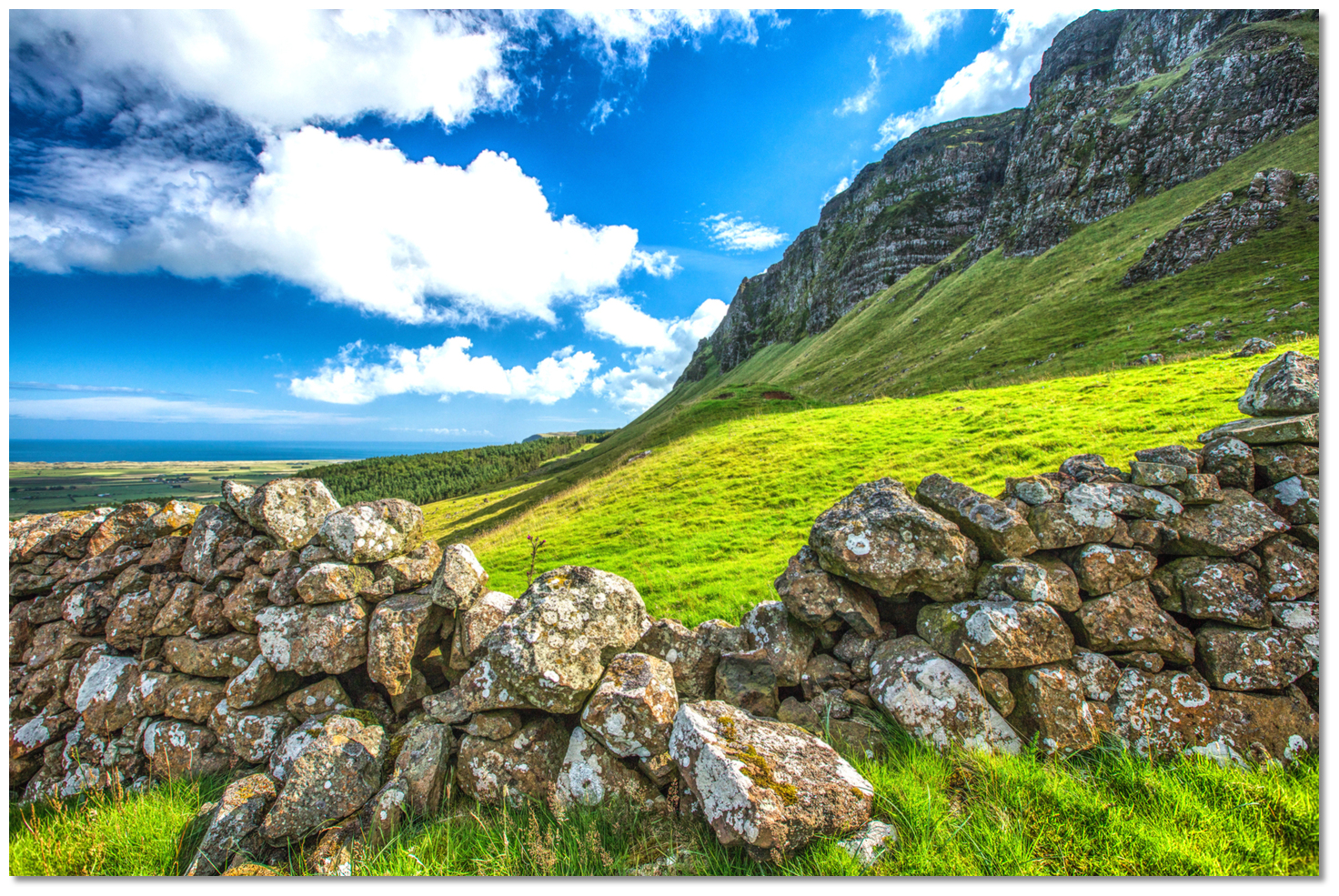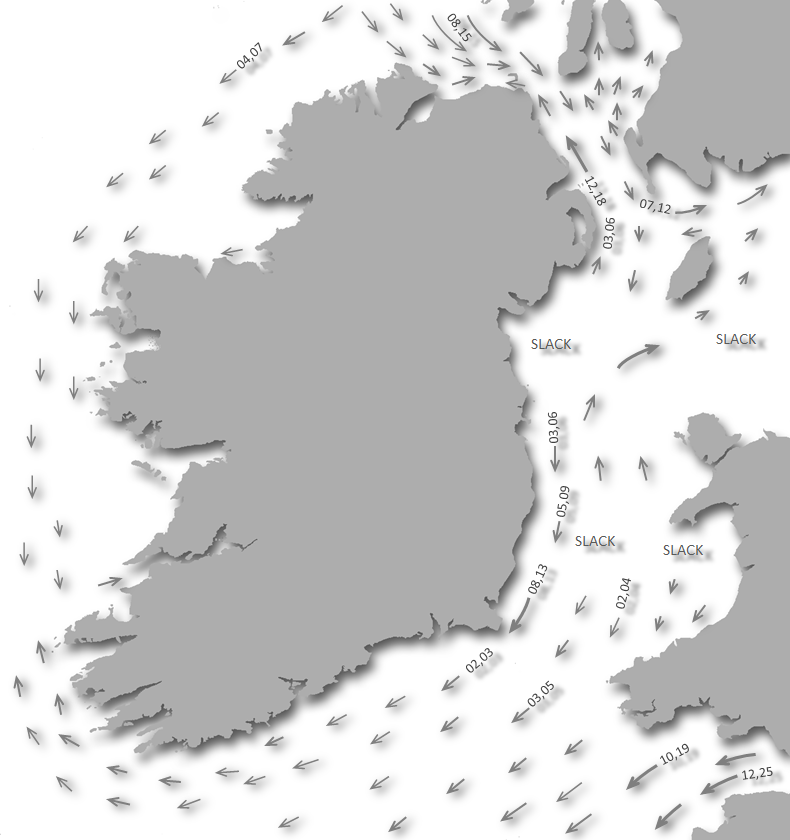
Set inside the north end of the Lough Foyle estuary and under the lee of Magilligan Point the point affords a good anchorage in east to northeast winds. The well-marked commercial shipping channel supported by a lighthouse with a sectored light provides safe access in all reasonable conditions and although tidal streams are occasionally strong, the anchorage is accessible at all states of the tide.
Keyfacts for Magilligan Point
Facilities




Nature








Considerations

Protected sectors
Approaches


Shelter


Last modified
February 2nd 2023 Summary
A good location with safe access.Facilities




Nature








Considerations

Position and approaches
Expand to new tab or fullscreen
Haven position
 55° 11.440' N, 006° 58.130' W
55° 11.440' N, 006° 58.130' WThis is approximately 100 metres southwest of the Magilligan Ferry Terminal that has a light on the end of the jetty 2F.R(vert)4m2M.
What is the initial fix?
The following Magilligan Point Initial Fix will set up a final approach:
 55° 11.666' N, 006° 58.395' W
55° 11.666' N, 006° 58.395' W What are the key points of the approach?
Offshore details are available in northeast Ireland’s Coastal Overview for Malin Head to Strangford Lough  .
.
 .
.- Lough Foyle’s approaches, the run up the lough to the River Foyle and beyond are detailed in the Foyle Port Marina (Derry City)
entry.
- Once within the entrance to the Lough make for the Magilligan Point pile structure light beacon and the Ferry Terminal.
- Keep 200 metres out from the beacon and 150 metres off of the Magilligan Point shoreline.
- Anchor to the southwest of the pierhead but not far southward as it quickly shallows.
Not what you need?
Click the 'Next' and 'Previous' buttons to progress through neighbouring havens in a coastal 'clockwise' or 'anti-clockwise' sequence. Below are the ten nearest havens to Magilligan Point for your convenience.
Ten nearest havens by straight line charted distance and bearing:
- Greencastle - 0.9 nautical miles NW
- Silver Strand - 1.1 nautical miles NNE
- Cornashamma Bay - 1.5 nautical miles NNE
- Moville - 2.5 nautical miles W
- White Bay - 2.7 nautical miles NNE
- Portnocker - 2.9 nautical miles NNE
- Carrickarory Pier - 3.1 nautical miles W
- Portkill - 3.3 nautical miles NNE
- Kinnagoe Bay - 4.3 nautical miles NNW
- Tremone Bay - 6 nautical miles NW
These havens are ordered by straight line charted distance and bearing, and can be reordered by compass direction or coastal sequence:
- Greencastle - 0.9 miles NW
- Silver Strand - 1.1 miles NNE
- Cornashamma Bay - 1.5 miles NNE
- Moville - 2.5 miles W
- White Bay - 2.7 miles NNE
- Portnocker - 2.9 miles NNE
- Carrickarory Pier - 3.1 miles W
- Portkill - 3.3 miles NNE
- Kinnagoe Bay - 4.3 miles NNW
- Tremone Bay - 6 miles NW
Chart
What's the story here?
 Magilligan Point
Magilligan PointImage: Michael Harpur
Magilligan Point terminates the low sand ridges that extend out from the coastal cliffs that mark the western extent of the Antrim Plateau. The low, flat sandy foreland forms the south point of entrance to Lough Foyle and is part British army firing range, part nature reserve and home to the HM Prison Magilligan.
 The ferry arriving at the Magilligan terminal from Greencastle on the western
The ferry arriving at the Magilligan terminal from Greencastle on the westernshore
Image: Michael Harpur
Its extremity is overlooked by a Martello Tower and close southwest is the seasonal car-ferry terminal with a small cluster of buildings backing it that includes a pub. The ferry service links Magilligan and Greencastle on the western shore.
 Magilligan Point
Magilligan Point Image: Michael Harpur
The anchorage under the lee of Magilligan Point provides a good shelter and holding over sand, in a sequestered area watching the comings and goings of the ferry.
How to get in?
 Magilligan Point as seen from the Inishowen Peninsula
Magilligan Point as seen from the Inishowen PeninsulaImage: Andrew Hurley via CC BY-SA 2.0
 Entered between Magilligan Point and the Inishowen shore, Lough Foyle’s approaches and the run up the lough to the River Foyle and beyond are detailed in the Foyle Port Marina (Derry City)
Entered between Magilligan Point and the Inishowen shore, Lough Foyle’s approaches and the run up the lough to the River Foyle and beyond are detailed in the Foyle Port Marina (Derry City)  entry.
entry.  The car ferry departing Greencastle
The car ferry departing GreencastleImage: Greg Clarke via CC BY SA 3.0
It is essential not to obstruct the car ferry that plies its way between the Magilligan and Greencastle. The service comes alongside the slip on the north side of the terminal. It runs hourly during the season from 8 am Monday to Friday and 9 am Saturday and Sunday, departing on the hour from Greencastle, with a 10-minute crossing time, and at 15 minutes past from Magilligan. Vessels operating in the Lough Foyle area should maintain a listening watch on the primary Foyle VHF Channel 14.
Image: Michael Harpur
From the entrance, it is simply a matter of making for the Magilligan Point light beacon off the point Q.R. 7m 4M and the Ferry Terminal. A good approach can be laid up by keeping 200 metres northwest (to port) of the Magilligan beacon. Then, whilst continuing southwestward, keeping the white tower of Warren Point, on the Inishowen shoreline, open of the beacon astern.
Image: Michael Harpur
 From the Magilligan Point steer in a bearing of 133° T for the outer end of the Magilligan Ferry Terminal that has a light 2F.R (vert) 4m2M.
From the Magilligan Point steer in a bearing of 133° T for the outer end of the Magilligan Ferry Terminal that has a light 2F.R (vert) 4m2M. Best depths are to be found beyond 150 metres of the Magilligan Point shoreline but take care not to drift southward. A shallow patch extends out a ⅓ of a mile west by northwest of the pier with a drying head at its extremity. A small section of this also dris to 0.4 metres LAT about 350 metres southwestward of the pier.
 Anchor south westward of the head of the ferry terminal
Anchor south westward of the head of the ferry terminalImage: Michael Harpur
 Anchor southwest of the head of the Magilligan Ferry Terminal. Do not go venture in too close to the pier as it dries out to the head, nor too far southward of the head as it gets shallow quickly. Tow the anchor in well as there is a strong tide in the area.
Anchor southwest of the head of the Magilligan Ferry Terminal. Do not go venture in too close to the pier as it dries out to the head, nor too far southward of the head as it gets shallow quickly. Tow the anchor in well as there is a strong tide in the area. The beach to the north of the ferry terminal
The beach to the north of the ferry terminalImage: Michael Harpur
Land by dinghy on the beach to the north of the Ferry Terminal.
Why visit here?
Magilligan Point derives its name from the Irish 'Aird Mhic Giollagáin' meaning 'MacGilligan's point'. The surname 'Mac Giollagáin', 'MacGilligan', or 'Magilligan' is indigenous to County Derry. The surrounding area, which formed a major part of the 'barony of Keenaght', was called 'MacGilligans country'. The foreland originated the acumulation of blown sands
The foreland originated the acumulation of blown sandsImage: Stephen via CC BY 2.0
The beach at the forward end of the huge Magilligan Peninsula started to develop as a result of sea and land level changes after the last ice age. It originated from deposits of alluvium and blown sand that accumulated to form the large 79,000 acres (32,000 ha) flat triangle of land in the lee of the long sand spit leading to Magilligan Point. The foreland is now fronted by the magnificent beaches of Downhill, Castlerock and Benone, also collectively known as Magilligan Strand, that sweep along the Londonderry coastline for more than 10 km (6 miles). The wide, golden stretch of sands is one of Ireland’s longest beaches and it has long since been granted EU Blue Flag status for its cleanliness.
 Overwatching Binevenagh dominates the Magilligan landscape
Overwatching Binevenagh dominates the Magilligan landscapeImage: Tourism Ireland
But it is the spectacular basalt escarpment of Binevenagh, or Benevenagh, that dominates the landscape here. Formed by molten lava around 60 million years ago the 385 metres high mountain marks the western extent of the Antrim Plateau. The name Binevenagh is derived from the Irish 'Binn Fhoibhne' meaning 'Foibhne's peak'. Legend has it that 'Foibhne', pronounced 'fovnees', was the son of the powerful Celtic Chief 'Taircheltar', pronounced 'tare - keltar', and the chief gave the mountain his son's name after he was slain here in pre-Christian times.
 View over Lough Foyle from Binevenagh's basalt escarpment
View over Lough Foyle from Binevenagh's basalt escarpmentImage: Tourism NI
It is said that Vikings, intent upon raiding the monastery of Derry, abandoned their plans when Binevenagh suddenly appear through the mist. They thought it was the biggest castle in the world. This is believable as the plateau and steep cliffs extend for over 6 miles across the peninsula of Magilligan and completely dominate the skyline. The combined area of mountains and foreland has been classified as both an Area of Special Scientific Interest and an Area of Outstanding Natural Beauty.
 The Vikings mistook Binevenagh for a castle
The Vikings mistook Binevenagh for a castleImage: Tourism NI
The point's signature Martello Tower was commenced in 1812 which was rather late in the British sequence of defences. Most Martello Towers were built to defend the Irish coastlines against the threat from Napoleon. Some of the later northern towers, including this one, were also intended to protect against a new naval threat during the 1812-1814 war with the United States of America. The original plan was to build a large-scale fortification at Magilligan Point to defend the narrow entrance to Lough Foyle but this had to be abandoned owing to its soft ground.
 Magilligan Point's signature Martello Tower
Magilligan Point's signature Martello TowerImage: Michael Harpur
A smaller scale tower was eventually decided upon with a corresponding tower built alongside the Norman ruins at Greencastle on the opposite shore. However, the Magilligan tower, together with the more unusual double gunned tower across at Greencastle, was not completed until 1817. This was two years after Napoleon was exiled to St Helena and three years after the war with America was over. As there were no more attempts to invade Ireland after 1798, the garrison stationed here never had to fire a shot at an enemy.
 The machicolated platform allowed for downward fire over the entrance
The machicolated platform allowed for downward fire over the entranceImage: Michael Harpur
The area would however prove strategically important during the Second World War. The well-sheltered natural harbour of Lough Foyle formed a vital base for convoys and escort ships waiting to cross the Atlantic. The top of the tower was then fitted out with a pillbox and the level land around Magilligan proved an ideal location for air force bases aimed at defending the harbour and the North Channel. As the war proceeded the Lough became the major focus for waging the Battle of the Atlantic and in 1945, the German U-boat fleet reported to surrender at Lisahally, at the mouth of the River Foyle.
 The Martello Tower was crowned by a pillbox during WWII
The Martello Tower was crowned by a pillbox during WWIIImage: Michael Harpur
Utilising a legacy of eight Nissen huts that were an army camp the once-notorious Magilligan Prison would open on the Magilligan spit in May 1972. It is today a medium to low-security prison that holds male prisoners with six years or less to serve. Orange parachute flares are occasionally fired there that may easily be mistaken for distress flares and are often reported as such. Also, small arms firing practice occasionally takes place on a range to the east of Magilligan Point. When the range is in use red flags are hoisted at flagstaffs on two lookout huts that are manned by sentries.
 Magilligan Prison overlooked by Binevenagh
Magilligan Prison overlooked by BinevenaghImage: Tourism NI
Today the dune system behind is Ireland's largest coastal accumulation of marine, wind-blown sand deposits and is the best-conserved dune system in the United Kingdom and Ireland. This beautifully sequestered expanse of shallow sea is home to a wide variety of waders and wildfowl, as well as over-wintering birds, including Brent geese. The dunes now form part of the Magilligan Point Nature Reserve and are protected. Likewise, the Magilligan Point Martello is one of the best preserved of the 40 surviving towers on the Irish coast. Since it was built, sand deposits have formed several ridges of dunes that have extended the peninsula by several hundred metres and the tower is now located a considerable distance from the sea. The tower has two 24-pounder, 11 kg, guns that are perfectly restored, but sadly it is mostly kept locked.
 Sunset Magilligan Point
Sunset Magilligan PointImage: Tourism NI
From a boating perspective, Magilligan Point is a remote anchorage with nothing but the ferry terminal and a few houses which also, vitally, include a pub. It is an ideal tide wait location at the lough entrance and provides another remote and interesting anchoring opportunity for the cruising boatman on this unique coastline.
What facilities are available?
There are no facilities at Magilligan Point save for a solitary pub and the jetty for the Magilligan-Greencastle ferry.Any security concerns?
Never an issue known to have occurred to a vessel anchored off Magilligan Point.With thanks to:
Bill McCann, Londonderry Harbour Master.Aerial views of Magilligan Point
Add your review or comment:
Please log in to leave a review of this haven.
Please note eOceanic makes no guarantee of the validity of this information, we have not visited this haven and do not have first-hand experience to qualify the data. Although the contributors are vetted by peer review as practised authorities, they are in no way, whatsoever, responsible for the accuracy of their contributions. It is essential that you thoroughly check the accuracy and suitability for your vessel of any waypoints offered in any context plus the precision of your GPS. Any data provided on this page is entirely used at your own risk and you must read our legal page if you view data on this site. Free to use sea charts courtesy of Navionics.



 +44 28 71860555
+44 28 71860555 harbourradio@londonderryport.com
harbourradio@londonderryport.com HM Website
HM Website Ch.14 [Harbour Radio]
Ch.14 [Harbour Radio]








